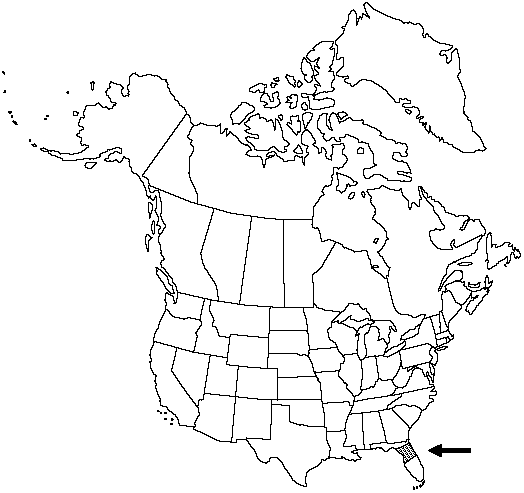Difference between revisions of "Asplenium pumilum"
Prodr. 129. 1788.
FNA>Volume Importer |
imported>Volume Importer |
||
| (7 intermediate revisions by 2 users not shown) | |||
| Line 12: | Line 12: | ||
|name=Asplenium pumilum var. anthriscifolium | |name=Asplenium pumilum var. anthriscifolium | ||
|authority=(Jacquin) Wherry | |authority=(Jacquin) Wherry | ||
| + | |rank=variety | ||
}} | }} | ||
|hierarchy=Aspleniaceae;Asplenium;Asplenium pumilum | |hierarchy=Aspleniaceae;Asplenium;Asplenium pumilum | ||
| Line 20: | Line 21: | ||
}}<!-- | }}<!-- | ||
| − | --><span class="statement" id="st- | + | --><span class="statement" id="st-undefined" data-properties=""><b>Roots </b>proliferous. <b>Stems</b> erect, unbranched; scales black with pale margins, linear, extremely narrow, 2–3 mm, only several cells wide. <b>Leaves</b> monomorphic. <b>Petiole</b> green in small leaves, black abaxially and green adaxially in large leaves, (1–)2–7(–16) cm, 1–2 times length of blade; indument of fine, nonglandular hairs on veins. <b>Blade</b> deltate, simple to 2-pinnate, 1–8(–12) × 1–6(–8) cm, thin, papery with scattered hairs on both surfaces; base truncate; margins crenate-dentate; apex pointed, not rooting. <b>Rachis</b> green, dull, glabrous. <b>Pinnae</b> in 0–5 pairs, ovate to deltate, simple to lobed to pinnate proximally, 1–6 × 1–3.5 cm, proximal pinna pair largest; base broadly cuneate to truncate; margins irregularly crenate; apex rounded to pointed. <b>Veins</b> free, evident. <b>Sori</b> 1–15(–35) per pinna, on both basiscopic and acroscopic sides. <b>Spores</b> 64 per sporangium. <b>2n</b> = 72.</span><!-- |
-->{{Treatment/Body | -->{{Treatment/Body | ||
| Line 26: | Line 27: | ||
|elevation=0–50 m | |elevation=0–50 m | ||
|distribution=Fla.;Mexico;West Indies;Central America;South America. | |distribution=Fla.;Mexico;West Indies;Central America;South America. | ||
| − | |discussion=<p>Asplenium pumilum is a widespread tropical American fern known only from a few spots in north central Florida. It is a very distinct species, readily recognized by its hairy blades and deltate leaves. Fertile forms vary from simple and only 2 cm to 2-pinnate and 28 cm, and all stages between the two extremes exist. Extreme forms are different enough to suggest that two species might be present.</p> | + | |discussion=<p><i>Asplenium pumilum</i> is a widespread tropical American fern known only from a few spots in north central Florida. It is a very distinct species, readily recognized by its hairy blades and deltate leaves. Fertile forms vary from simple and only 2 cm to 2-pinnate and 28 cm, and all stages between the two extremes exist. Extreme forms are different enough to suggest that two species might be present.</p> |
|tables= | |tables= | ||
|references= | |references= | ||
| Line 35: | Line 36: | ||
-->{{#Taxon: | -->{{#Taxon: | ||
name=Asplenium pumilum | name=Asplenium pumilum | ||
| − | |||
|authority=Swartz | |authority=Swartz | ||
|rank=species | |rank=species | ||
| Line 49: | Line 49: | ||
|publication year=1788 | |publication year=1788 | ||
|special status= | |special status= | ||
| − | |source xml=https:// | + | |source xml=https://bitbucket.org/aafc-mbb/fna-data-curation/src/2e0870ddd59836b60bcf96646a41e87ea5a5943a/coarse_grained_fna_xml/V2/V2_822.xml |
|genus=Asplenium | |genus=Asplenium | ||
|species=Asplenium pumilum | |species=Asplenium pumilum | ||
| − | |||
| − | |||
| − | |||
| − | |||
| − | |||
| − | |||
| − | |||
| − | |||
| − | |||
| − | |||
| − | |||
| − | |||
| − | |||
| − | |||
| − | |||
| − | |||
| − | |||
| − | |||
| − | |||
| − | |||
| − | |||
| − | |||
| − | |||
| − | |||
| − | |||
| − | |||
| − | |||
| − | |||
| − | |||
| − | |||
| − | |||
| − | |||
| − | |||
| − | |||
| − | |||
| − | |||
| − | |||
| − | |||
| − | |||
| − | |||
| − | |||
| − | |||
| − | |||
| − | |||
| − | |||
| − | |||
| − | |||
| − | |||
| − | |||
}}<!-- | }}<!-- | ||
-->[[Category:Treatment]][[Category:Asplenium]] | -->[[Category:Treatment]][[Category:Asplenium]] | ||
Latest revision as of 20:25, 5 November 2020
Roots proliferous. Stems erect, unbranched; scales black with pale margins, linear, extremely narrow, 2–3 mm, only several cells wide. Leaves monomorphic. Petiole green in small leaves, black abaxially and green adaxially in large leaves, (1–)2–7(–16) cm, 1–2 times length of blade; indument of fine, nonglandular hairs on veins. Blade deltate, simple to 2-pinnate, 1–8(–12) × 1–6(–8) cm, thin, papery with scattered hairs on both surfaces; base truncate; margins crenate-dentate; apex pointed, not rooting. Rachis green, dull, glabrous. Pinnae in 0–5 pairs, ovate to deltate, simple to lobed to pinnate proximally, 1–6 × 1–3.5 cm, proximal pinna pair largest; base broadly cuneate to truncate; margins irregularly crenate; apex rounded to pointed. Veins free, evident. Sori 1–15(–35) per pinna, on both basiscopic and acroscopic sides. Spores 64 per sporangium. 2n = 72.
Habitat: Shaded limestone boulders
Elevation: 0–50 m
Distribution

Fla., Mexico, West Indies, Central America, South America.
Discussion
Asplenium pumilum is a widespread tropical American fern known only from a few spots in north central Florida. It is a very distinct species, readily recognized by its hairy blades and deltate leaves. Fertile forms vary from simple and only 2 cm to 2-pinnate and 28 cm, and all stages between the two extremes exist. Extreme forms are different enough to suggest that two species might be present.
Selected References
None.